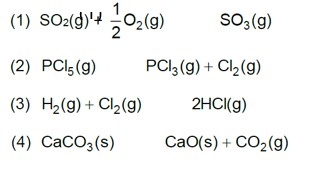7.18. Ethyl acetate is formed by the reaction between ethanol and acetic acid and the equilibrium is represented as:
CH3COOH (l) + C2H5OH (l) ⇌CH3COOC2H5 (l) + H2O (l)
(i) Write the concentration ratio (reaction quotient), Qc, for this reaction (note: water is not in excess and is not a solvent in this reaction)
(ii) At 293 K, if one starts with 1.00 mol of acetic acid and 0.18 mol of ethanol, there is 0.171 mol of ethyl acetate in the final equilibrium mixture. Calculate the equilibrium constant.
(iii) Starting with 0.5 mol of ethanol and 1.0 mol of acetic acid and maintaining it at 293 K, 0.214 mol of ethyl acetate is found after sometime. Has equilibrium been reached?
7.18. Ethyl acetate is formed by the reaction between ethanol and acetic acid and the equilibrium is represented as:
CH3COOH (l) + C2H5OH (l) ⇌CH3COOC2H5 (l) + H2O (l)
(i) Write the concentration ratio (reaction quotient), Qc, for this reaction (note: water is not in excess and is not a solvent in this reaction)
(ii) At 293 K, if one starts with 1.00 mol of acetic acid and 0.18 mol of ethanol, there is 0.171 mol of ethyl acetate in the final equilibrium mixture. Calculate the equilibrium constant.
(iii) Starting with 0.5 mol of ethanol and 1.0 mol of acetic acid and maintaining it at 293 K, 0.214 mol of ethyl acetate is found after sometime. Has equilibrium been reached?
-
1 Answer
-
(i) The concentration ratio (Concentration quotient), Qc for the reaction is:
Qc = [CH3COOC2H5] [ H2O] / [CH3COOH] [C2H5OH]
(ii)
CH3COOH
C2H5OH
CH3COOC2H5
H2O
Initial molar concentration
1.0 mol
0.18 mol
0
0
Molar concentration at equilibrium
(1 – 0.171) = 0.829 mol
(0.18 – 0.171) = 0.009 mol
0.171 mol
0.171 mol
Applying
Kc = [CH3COOC2H5] [H2O] / [CH3COOH] [C2H5OH]
= (0.171 mol) x (0.171 mol) / (0.829 mol) (0.009 mol)
= 3.92
(iii)
CH3COOH
C2H5OH
CH3COOC2H5
H2O
Initial molar concentration
1.0 mol
0.5 mol
0.214 mol
0.214 mol
Molar concentration at equilibrium
(1 – 0.214) = 0.786 mol
(0.5 – 0.214) = 0.286 mol
0.214 mol
0.214 mol
Qc = [CH3COOC2H5] [H2O] / [CH3COOH] [C2H5OH]
= (0.214 mol) x (0.214 mol) / (0.786 mol) (0.286 mol)
= 0.204
Since Qc is less than Kc, this means that the equilibrium has not been reached. The reactants are still taking part in the reaction to form the products.
Similar Questions for you
0.01 M NaOH,
M = 1 * 10-2

pOH = 2
pH = 2
Kp = Kc (RT)Dng
36 * 10–2 = Kc (0.0821 * 300)–1
Kc = 0.36 * 0.0821 * 300 = 8.86 » 9
A(g) ->B(g) + (g)
Initial moles n 0 0
Eqb. moles n(1 – a) na
total moles =
Eqb. pressure
On increasing pressure, equilibrium moves in that direction where number of gaseous moles decreases.
Taking an Exam? Selecting a College?
Get authentic answers from experts, students and alumni that you won't find anywhere else
Sign Up on ShikshaOn Shiksha, get access to
- 65k Colleges
- 1.2k Exams
- 679k Reviews
- 1800k Answers


